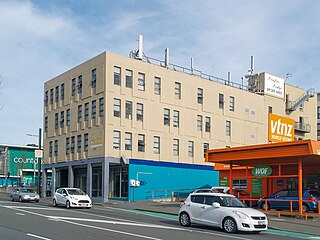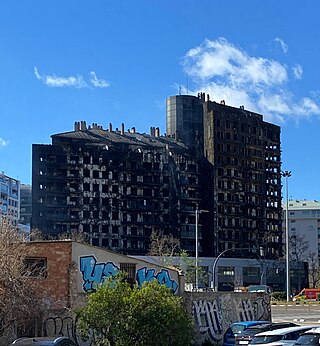
La Samaritaine is a large department store in the first arrondissement of Paris; the nearest metro station is Pont-Neuf. Founded in 1870 by Ernest Cognacq it is now owned by the luxury goods conglomerate LVMH.
The Lakanal House fire occurred in a tower block on 3 July 2009 in Camberwell, London. Six people were killed, and at least 20 injured, when a high-rise fire, caused by a faulty television set, developed and spread through a number of flats in the twelve-storey building.

The Penhallow Hotel fire was a suspected arson attack that occurred in Newquay, Cornwall on 18 August 2007. Three people were killed and it was reported as the worst hotel fire in the United Kingdom in nearly 40 years. The hotel was a well-known hotel for holiday makers ranging from families to older residents. It had been built in Island Crescent between 1912 and 1917, and had been altered more than once. The building had a wooden fire escape at the rear, and a central light shaft running from the ground floor up to the roof in the centre of the hotel. Both of these aspects of the building played a dramatic role in the outcome of the fire. Many of those that escaped the fire were elderly holiday makers.

The 2010 Shanghai fire was a fire on 15 November 2010 that destroyed a 28-story high-rise apartment building in the heart of Shanghai, China, killing at least 58 people and injuring more than 70 others. Most of the residents were retired state school senior educators. It is remembered as an iconic high-rise fire in China in the 2010s.

The Paris Metropolitan Area includes a Japanese community. In 2023, the official number of Japanese residents in Paris was 10,592, compared to 16,277 a decade prior.

On 14 June 2017, a high-rise fire broke out in the 24-storey Grenfell Tower block of flats in North Kensington, West London, England, at 00:54 BST and burned for 60 hours. Seventy people died at the scene and two people died later in hospital, with more than 70 injured and 223 escaping. It was the deadliest structural fire in the United Kingdom since the 1988 Piper Alpha oil-platform disaster and the worst UK residential fire since the Blitz of World War II.

The Harrow Court fire occurred in a tower block on 2 February 2005 in Stevenage, Hertfordshire, England. Three people were killed, two of them firefighters, when a fire developed and spread from the 14th floor. An investigation of the fire found that there was an Abnormal Rapid Fire Development, caused by a candle melting the surface of a television, which then spread rapidly up the outside of the building to subsequent floors.

On 25 March 2018 at 16:00 local time, a fire engulfed the Winter Cherry shopping mall and entertainment complex in Kemerovo, Russia. It killed at least 60 people according to official statements. The blaze started somewhere on the top floor of the four-story complex, and people were seen jumping from windows to escape it. 100 people were evacuated, and another 20 were rescued. Others claim the number of people killed in the fire is being covered up, and that the real figure runs into the hundreds. According to the Russian authorities, the source of these rumors was a Ukrainian prankster who called the morgue posing as an emergency services officer. In 2018, he uploaded recordings of these calls to his YouTube channel and confirmed the calls during subsequent interviews.
On 5 February 2019, a fire killed at least 10 people and injured at least 36 others at an apartment block on Rue Erlanger in Paris' 16th arrondissement, France, making it the deadliest fire in the French capital since 2005.
On 9 August 2020, a major fire broke out in early morning hours at a COVID-19 facility located at the Hotel Swarna Palace in the city of Vijayawada, in the state of Andhra Pradesh. The fire blaze killed 11 people and wounded a further 22. The hotel was used as a temporary COVID-19 facility as it was leased out by the private hospital Ramesh Hospitals Vijayawada for the purpose of treating infected COVID-19 patients. An electrical short circuit was described as the ultimate reason for the incident. The fire had been brought under control by the firefighters within a space of 30 minutes. The patients who survived from the fire blaze were transferred to another quarantine centre.

In the early morning hours of 14 October 2021, at 02:54 NST (UTC+8), a fire broke out in a 13-storey building at Fubei Road in Yancheng District, Kaohsiung, a city in southwestern Taiwan. At least 46 people were killed, and 41 others were injured. The fire was extinguished after about four and a half hours. The cause of the fire is under investigation, although piles of debris left around the building may have complicated rescue efforts and helped fuel the fire.
On the morning of January 5, 2022, a fire tore through a row house converted into apartments in the Fairmount neighborhood of Philadelphia, Pennsylvania. Twelve people died, nine of them children, and two others were injured. Five additional people escaped from the first floor unit with minor injuries. The fire happened just four days before the 2022 Bronx apartment fire, also in the Northeastern United States.
On the morning of January 9, 2022, a high-rise fire killed seventeen people, including eight children, at the Twin Parks North West, Site 4, high-rise apartment building in the Bronx, New York City, United States. Forty-four people were injured, and thirty-two with life-threatening injuries were sent to five different borough hospitals. Fifteen were in critical condition the day after the fire.

On 16 May 2023, a fire broke out at the 92-bed Loafers Lodge in Newtown, Wellington, New Zealand. Five people were killed, and twenty others injured. On 18 May 2023, a man, whose identity is still suppressed, was arrested. He was charged with arson and murder.

On 22 February 2024, at approximately 17:30 CET, a fire broke out in a 14-storey luxury residential complex located in the Campanar district of Valencia, Spain. The rapid spread of the fire, exacerbated by strong winds, building materials and a stack effect, led to the complete destruction of the complex's 138 apartments, trapping numerous residents inside.
The Freshwater Road fire was a fire that broke out in the Spectrum Building, a block of flats on Freshwater Road, Dagenham on 26 August 2024. Four people were injured and treated at the scene with a further two being taken to hospital. Comparisons were immediately drawn to the 2017 Grenfell Tower fire by several news outlets.

On 21 January 2025, a fire at the Grand Kartal Hotel in the Kartalkaya ski resort in Bolu Province, Turkey, killed at least 78 people, and injured 51 others.










